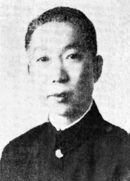Senrian Occupation of Jindao
This article is incomplete because it is pending further input from participants, or it is a work-in-progress by one author. Please comment on this article's talk page to share your input, comments and questions. Note: To contribute to this article, you may need to seek help from the author(s) of this page. |
Senrian Jindao 千龍金島 Senryuu Kintou | |||||||||
|---|---|---|---|---|---|---|---|---|---|
| 1933–1935 | |||||||||
| Status | Military occupation by the Republic of Senria | ||||||||
| Common languages | Senrian Xiaodongese Gaullican | ||||||||
| Government | Military occupation | ||||||||
| Prime Minister | |||||||||
• 1933–1935 | Katurou Imahara | ||||||||
| Governor-General | |||||||||
• 1933–1935 | Hatirou Nakayama | ||||||||
| Historical era | Great War | ||||||||
| 10–17 May 1933 | |||||||||
• Surrender of Jindao | 17 May 1933 | ||||||||
| 23 April 1935 | |||||||||
• Handover to Estmere | 25 April 1935 | ||||||||
| Area | |||||||||
| 1933 | 1,125 km2 (434 sq mi) | ||||||||
| 1935 | 1,125 km2 (434 sq mi) | ||||||||
| Population | |||||||||
• 1933 | 566,715 | ||||||||
• 1935 | 435,465 | ||||||||
| Currency | Senrian yen | ||||||||
| |||||||||
| Today part of | |||||||||
The Senrian Occupation of Jindao was a military occupation of the city of Jindao, then under the colonial rule of Gaullica but effective military control of Xiaodong, by the Republic of Senria from the Senrian victory in the Battle of Jindao on May 17, 1933 to the signing of the Treaty of Keisi and subsequent handover to Estmere on April 23–25, 1935. Gaullican colonial governor Égide Brassard was the final governor of the city, but was shot by a Senrian sniper after trying to flee the city on May 15. The occupation is known for its brutality, which displayed a series of mass murders and deportations by Senrian troops. The occupation was one of the longest Senria held on the Xiaodongese mainland, lasting almost a year and a half. The occupation saw the population of Jindao decline by almost 20%, a number that would only take until 1937 to recover.
Background
Senrian invasion of Xiaodong
Battle of Jindao
Politics
Almost immediately after Jindao was seized from Gaullica, Senria declared martial law in the city and gave soldiers in the city almost unlimited powers over the civilian populace. Emphasised by the authoritarian rule of Hatirou Nakayama due to his losses in the Senrian Genocide, Jindao was led fiercely by the Senrian general throughout the occupation. The Senrians utilised the renaming of many major landmarks in Jindao to Senrian-equivalent names, with many street names and districts also being given Senrian names, whilst their Xiaodongese counterparts were outlawed from use. Senrian became a mandatory language to learn for the populace whilst under occupation.
The administrative and military headquarters for the occupational government were set up in the Islands district, making it difficult for guerrilla forces or terrorists to reach the building, the waters being guarded by the Senrian Navy. The military also comprised all political infrastructure within Jindao, including the judiciary, which made the persecution of Xiaodongese prisoners-of-war, some 4,500 of which were captured within Jindao, extremely easy for the Senrian government to achieve. Xiaodongese troops were kept in harsh prisoner-of-war camps and typically sent to Senria as forced labor or executed within months, mainly in the Chih Te Mo Internment Facility in the south-west of the city. By 1934, the city had lost most of its explicit Xiaodongese characteristics.
Policing in Jindao was conducted by the military, with patrol units often roaming the streets in lieu of an organised police force, which the Senrian government never arranged. Strict curfews were issued throughout the city and those seen outside their residencies outside of curfew hours were regularly shot on sight and their corpses disposed in public places as a warning to other civilians for the consequences of disobedience. St. Chloe's Hospital routinely became full with injured Jindanese civilians in 1933 until Nakayama transformed it into a military hospital and forbade the staff from treating non-Senrians.
Economy
The local economy of Jindao suffered heavily as Senria tried to rapidly integrate the city into the expanding Senrian keiretu economic system. Reserves of the Jindanese denier were seized and physical money was often stolen in raids on civilian homes. The Jindanese denier was often used to fund the Senrian war efforts in Xiaodong, while the currency itself was quickly made illegal tender and replaced with the Senrian yen. Despite oppressive rule by the Senrians in Jindao, the city was made a priority to repair, mainly due to the aspirations of both Imahara and Nakayama to gain the city in the resulting peace treaty with Xiaodong and the Entente. Although the emphasis on a rebuild assisted Jindao somewhat, many of its core institutions faltered due to widespread damage throughout the city. Conscripted labourers from Jindao were often used to repair roads, buildings, and to Senrianise the city, while the majority were deported to the island of Tousuu in Senria to assist in rebuilding efforts. Banks, mainly Xiaodongese and Gaullican, were targeted by Senrians as a means to propagate Senrian influence over the city, with many of the banks being liquidated to make way for new Senrian institutions. Many non-conscripted labourers were unemployed within the city, a large portion of whom shipbuilders, whose workplaces were targeted by Senria during air raids over Jindao to limit the Entente's naval ability in the Bay of Bashurat.



